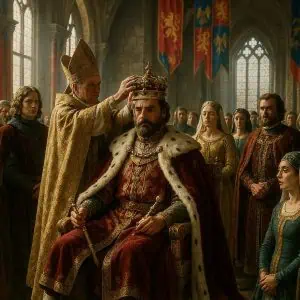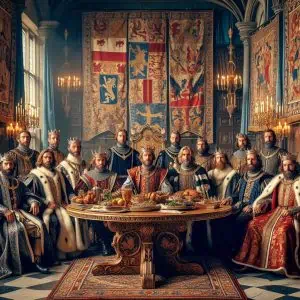The Angevin kings of England, a dynasty originating from the French region of Anjou, left a profound mark on English history. Starting with Henry II and continuing through rulers like Richard the Lionheart and King John, this line of monarchs oversaw territorial expansion, legal reforms, and military campaigns that shaped medieval England. While celebrated for their achievements, they also faced rebellions, political intrigue, and personal challenges, revealing the complexities behind their legacy. This article provides a comprehensive list of Angevin kings and examines the influence each ruler had on their kingdom and beyond.
Known for their connections to the House of Anjou in France, these monarchs significantly impacted the development of English law, government, and international relations.
Here is a list of the Angevin kings who ruled England during this fascinating period.
1. Henry II (1154-1189)
Henry Plantagenet, the first Angevin king, ascended to the English throne in 1154. He brought significant changes to the English legal system with his establishment of the common law and the expansion of royal authority.
Henry’s reign was also marked by conflicts with Thomas Becket, the Archbishop of Canterbury, and rebellions within his own family, including his sons’ revolts.

2. Richard I (1189-1199)
Known as Richard the Lionheart, he was a renowned military leader and a prominent figure in the Third Crusade. Richard spent much of his reign abroad, leading campaigns in the Holy Land, leaving the governance of England to regents.
His absence, along with his heavy taxation to fund his military adventures, led to unrest in England.

3. John (1199-1216)
John, the youngest son of Henry II, faced numerous challenges during his reign. His rule was marred by conflict with the Church, particularly his dispute with Pope Innocent III over the appointment of the Archbishop of Canterbury, which led to the interdict on England.
Additionally, John’s arbitrary taxation and abuses of power culminated in the revolt of the barons, resulting in the sealing of the Magna Carta in 1215, a document that laid the foundation for constitutional liberties in England.

4. Henry III (1216-1272)
The son of King John, Henry III came to the throne as a child, leading to a period of regency until he reached maturity. His reign was marked by a lengthy struggle with the barons, who sought to limit the king’s power.
Despite facing several challenges, including the Second Barons’ War, Henry III managed to strengthen the monarchy’s administrative institutions.

The Angevin kings of England left a lasting impact on the nation’s history. Their reigns witnessed the development of the English common law, early parliamentary structures, and significant interactions with continental Europe, particularly the Angevin Empire in France.

The struggles and conflicts during their rule also laid the foundation for the emergence of constitutional principles and the limitation of royal authority in England. These kings, with their complex and often turbulent reigns, played a crucial role in shaping the trajectory of the English monarchy and the nation itself.
📜 Frequently Asked Questions
Who were the Angevin kings of England?
The Angevin kings were a dynasty originating from Anjou in France. Key rulers include Henry II, Richard I, and King John, who ruled England between 1154 and 1216.
Why were the Angevin kings significant?
They expanded the English realm through conquest, established important **legal reforms** like the foundation of common law, and shaped the monarchy’s influence across Europe.
What challenges did the Angevin kings face?
The dynasty faced frequent **rebellions, conflicts with nobles**, disputes with the church, and succession crises, highlighting the difficulties of medieval kingship.
Who was Henry II and what was his legacy?
Henry II strengthened royal authority, reformed the legal system, and expanded English territories, leaving a lasting mark on governance and law.
Why is Richard the Lionheart famous?
Richard I is best remembered for his military prowess, leadership during the Crusades, and his reputation as a chivalric hero.
What was King John known for?
King John is often infamous for losing territories in France, conflicts with the nobility, and being forced to sign the Magna Carta.
How did the Angevin dynasty influence England?
Their reign helped establish the **foundations of English common law**, centralize royal authority, and influence European politics, leaving a legacy that endured for centuries.






